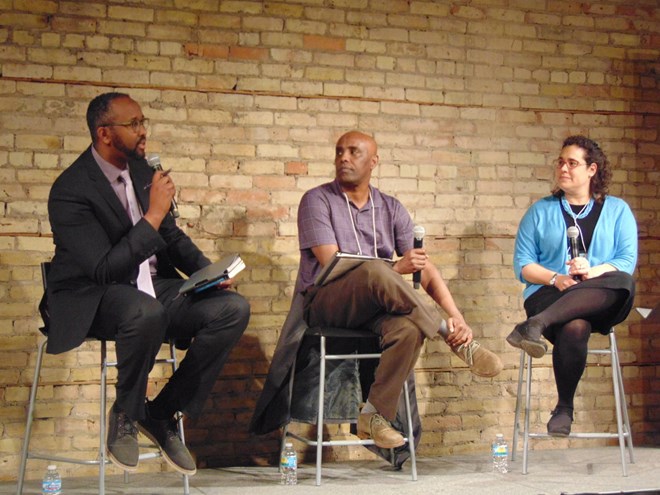Minnesota Spokesman Recorder
Wednesday August 16, 2017

(l-r) Jaylani Hussein, Ahmed Ismail Yusuf, Stefanie Chambers/ (Charles Hallman/MSR News)
he United States, and Minnesota in particular, has been a prime destination for Somalis since the 1980s. Many came here to attend college; others came to start anew and establish businesses. A large influx of Somali refugees later arrived during the mid-1990s as a result of Somalia’s civil war.
Jaylani Hussein and his family came from their native land to the States in 1993 and relocated in Minnesota. “I believe the reason why we came to Minnesota was one of our relatives came here as an exchange student in 1970 and he stayed here,” recalled the executive director of the Minnesota chapter of the Council on American-Islamic Relations (CAIR-MN).
The ‘first wave’ of Somalis to Minnesota “laid the foundation” for others to arrive later, said author and playwright Ahmed Ismail Yusuf.
Hussein recalled the “tremendous pushback” against Islamic Somalis following September 11, 2001.
In recent years, large populations of Somalis have grown to prominence in three cities; the largest is in Minneapolis, then Columbus, Ohio and Seattle, Washington. Somalians have also moved in large numbers to Virginia outside of Washington, D.C., to Maine, and to rural areas around the country, including Greater Minnesota.
“The entire downtown Willmar is inhabited with Somali shops. It’s not like your typical image of what a Greater Minnesota city looks like,” he said.
This past spring, Hussein, Yusuf and Associate Professor Stefanie Chambers from Trinity College in Connecticut discussed Somalis in Minnesota and in the U.S. at the Open Book in downtown Minneapolis, attended by the MSR.
This year, Chambers published Somalis in the Twin Cities and Columbus (Temple University Press) to present a “factual portrait” of Somalis. She did a comparative study to examine political, economic and social similarities and differences between the two cities to see how Somalis incorporated themselves in the two locales.
“This topic has become really important [since] then-candidate Donald Trump made [false statements] about Somalis in Minnesota, saying, ‘Here in Minnesota you’ve seen first-hand the problems…of large numbers of Somali refugees coming into the state without your knowledge,” said Chambers. “The reality is far different than what is painted by the President of the United States.”
In Minnesota in 2006, Somalis reportedly had a purchasing power of between $164 and $394 million and owned 600 businesses ranging from halai meat to men’s and women’s clothing, jewelry, video rentals, and Somali-specific items not readily found in mainstream stores.
Some of the businesses do not make a profit; many are operated only part-time. Hussein noted that while men dominate some of the larger businesses, “If you look at the entire body, the majority is run by women.” Women own about 70 percent of the businesses with five or fewer employees.
Chambers observed that the Twin Cities seems “a little bit better” for Somalis than those who live in Columbus. But she quickly noted that in both cities Somalis “are at the bottom” in homeownership rates.
“Politically, academically, economically and socially we see very positive things happening for Somalians in the Twin Cities,” Chambers told MSR. But she added there is still room for improvement, “…especially where it relates to economic situations in the region.”
“Somalians struggle politically in Columbus,” she pointed out. “The [major] political parties make no effort to engage them — no Somali elected officials. The unions don’t include Somalians — they are a non-unionized work force.”
The professor estimates there are between 45,000 and 65,000 Somalis in Minneapolis, but undercounting might be affecting the numbers. Some Somalis distrust officials for fear that any information given may be used against them.
Some Somali families live in overcrowded housing conditions to save money to buy a house as well as for other reasons. Islamic law prohibits borrowing money and paying interest on it, said the CAIR-MN executive director. “People are not very comfortable [talking] about living in a two-bedroom apartment — they might be concerned about eviction.”
Most Somalis also tend to associate within their own circles, but Hussein strongly encourages them to reach out to others. “I’ve learned a lot from the Hmong community. We’ve learned from each other. I think our [ethnic] communities need to overlap and talk.”
Hussein would also like more interaction with Black Americans. “Somalians are subject to the same type of harassment and bigotry that African Americans [are subject to],” he said. “Unfortunately, in this state the African American community is much smaller [and] less organized, and that creates a great deal of difficulty on how do we work together.
“We need both communities to work [together],” said Hussein, “because our children and future generations’ fates are similar in nature.”